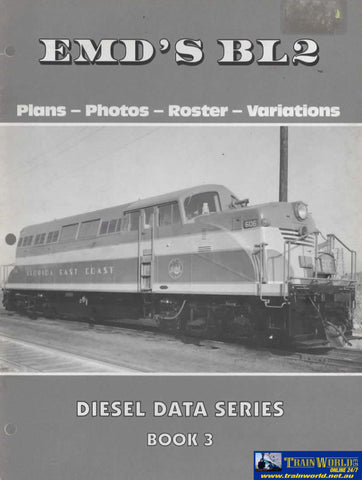Diesel Data Series Book #03: EMD's BL2 'Plans, Photos, Roster & Variations' (UHUN-BL2)
Product No.: UHUN-BL2
Title: Diesel Data Series Book #03: EMD's BL2 'Plans, Photos, Roster & Variations'
Author(s): Hundman, R.
Illustrator(s): N/A
Publisher: Hundman Publishing
ISBN: N/A
Condition: New
Binding: Softcover
Dust Jacket: None
Edition: 1st Edition
Publication Year: Appox. 1998
Features: 18 Pages with Black/White Photos & Line Drawings.
The EMD BL2 was a four-axle B-B road switcher built by General Motors Electro-Motive Division (EMD). Often considered the "Ugly Duckling" of diesel offerings from EMD, the BL2 set the stage for the company's widely successful GP series of locomotives. EMD's diesel program was well underway in the late 1940s and early 1950s, thanks to the success of the company's FT demonstrations across the country.
While the F-units in production were great for moving trains over the railroad, their full-width carbody made it difficult for locomotive crews to see to the rear of the locomotive. The F-units also lacked anywhere for a brakeman or switchman to stand and ride short distances while performing switching duties. The F-units did have grab irons and stirrup steps, but these features were a hindrance in locations with tight clearances.
Since the engine inside the locomotive's hood didn't take up the full carbody width, it seemed only logical that the hood could be "cut away" a bit to allow the crew to see and ride safely. This wasn't an entirely new idea either, as the Pennsylvania Railroad's GG1 fleet, which featured large cutout sections in its hoods, had been in service since 1934. Another problem facing EMD was that ALCO was making inroads into a market that EMD would have liked to keep to themselves; ALCO's RS series road-switchers were starting to take over many of the tasks that EMD wanted to fulfill with their own locomotives.
Likewise, Baldwin and Fairbanks-Morse had started their own models of road-switchers. EMD's designers and engineers set to work and came up with the carbody reminiscent of the GG1 with mechanics that contained the technical knowledge they had learned with the company's F-unit series. Starting from an F3, the product of their efforts became the BL1 EMD Demonstrator #499. The BL in the locomotive's model name officially stood for "Branch Line", indicating that EMD felt the locomotive was best suited for light traffic and frequent switching chores. The BL1 and BL2 differed only in mechanical details.
The only BL1 was built with an air-actuated throttle and could not MU with other units. The air throttle was replaced with a standard electrically-actuated throttle and became essentially a BL2. The production BL2 used the standard electrically actuated throttle as used in the F3 and 58 BL2s were built and sold to a few railroads, primarily in the eastern and midwestern United States. This model of locomotive was sold for both freight and passenger service and the locomotive's intended purpose could be easily identified by the presence or absence of an exhaust stack between the two windshield panes.
This exhaust stack was for the steam generator on passenger service units. Limiting the locomotive's success were several mechanical and ergonomic features. The mechanical components within the engine compartment were difficult to access and maintain, reducing its appeal among railroad shop crews. The locomotive's carbody lacked the full-length walkways of subsequent GP diesels, making it difficult for the brakeman or switchman to move from one point on the locomotive to another during switching operations.
Finally, although the industrial designers at EMD tried to build a carbody that evoked high-class passenger trains while retaining the utilitarianism of railroad work, the visual design never quite caught on. However, even though the BL2 didn't succeed very well, EMD's engineers learned quite a bit from the endeavor and incorporated all of the good ideas from it into the company's widely successful GP series of locomotives.



